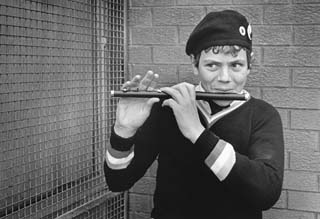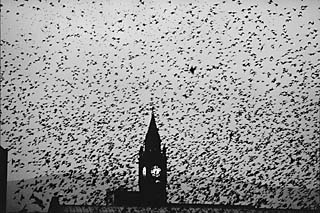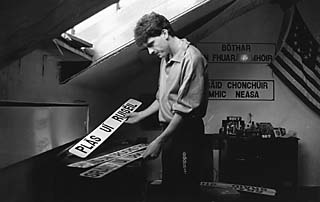|
"Ní liom é ní leat é, ní
le héinne ar leith é. 'S é an rud é, cultúr,
ná an méid a dhéannan sé."
(Culture is not the preserve of any one set of people or
of any one class. Culture is what culture does.)
Tradition and Identity
It is often said that there are two traditions, or two cultures in
Ireland. There are not. There are scores of traditions, maybe hundreds,
all making up a diverse and rich culture. All equally valid. All part
of what we are. Urban and rural. Small town and hill village. Fishing
port and island. Inner city and farming community. Gaeltacht1 and Gallteacht.2
Labourer and artisan. Visual, literary and oral. Feminist. Song and
dance. Orange and green. Hurling and rugby. Football and handball. Pagan
and Christian. Protestant and Catholic. North and south. East and west.
The midlands. These traditions and all that they represent do not conflict.
They are part of the diversity of Irishness.
Culture involves every aspect of our lives, and is not restricted to
the artistic expressions which humankind has developed. Culture is the
ideas and attitudes of people; it is an indication of how we view things,
and it is our response to the environment in which we live. National
culture is the reflection of the politics, economics, values, attitudes,
aspirations and thoughts of a nation. It is the totality of our response
to the world we live in.
Precisely because this is so, cultural colonalism formed and forms
a major part of the conquests by some nations over other nations. This
is certainly the case in Ireland. I have no doubt that this is true
also of other colonised cultures.
Cultural colonialism demands the lowering of national spirit, the revision
of history and the destruction of separate identity. It seeks to substitute
men and women for mere objects. Objects have no allegiance-- they are
for sale. As Padraig Pearse, the Irish poet, teacher and leader of the
1916 Easter Rising wrote of the English education system in Ireland:
The English have established the simulacrum of an educational system
but its object is the precise contrary of the object of an educational
system. Education should foster; this education is meant to repress.
Education should inspire; this education is meant to tame. Education
should harden; this education is meant to enervate.3
Hundreds of years of such 'education' had its effect. In Ireland today
a culture of dependency has been created. This reflects the ethos of
survivalism engendered by centuries of British colonialist and imperialist
oppression. In other words, it reflects the politics, economics, values,
attitudes and thoughts of our rulers.
The Siege of Derry,4 like the Battle of the Boyne,5 is as much an influence
and a part of Irish history as the Siege of Limerick,6 the Famine or
the Easter Rising of 1916. It reminds us also of the need to stress
that 'Brits Out' is not a call, as is often mischievously suggested,
for the banishment of Unionists. On the contrary, a peaceful, just and
united society in Ireland must offer equal rights to everyone, Loyalist
and Nationalist alike.
But this term 'two traditions' or 'two cultures' is a term which is
incorrectly and often deliberately misused to describe what are in fact
two different and conflicting political allegiances. They conflict because
one expresses a notion of allegiance to the union with Britain while
the other expresses a notion of allegiance to Ireland, to all the people
of the island. There is not a clash of traditions or culture in Ireland.
There is a division of allegiance created and sustained by British interference
in our affairs.
The civil rights struggle was the beginning of the end of all this.
The civil rights demands put the British state to a test. The state
failed this test and reacted with terrorism. The demands were both moderate
and modest: the right to vote at local government level, an end to discrimination
in employment and the scrapping of repressive legislation. Almost thirty
years later, Catholics are still twice as likely to be unemployed, and
repressive legislation continues to deny citizens their basic democratic
rights.
In 1969 the state died. It was revived by the British government, and
since then has been kept alive on a life-support unit of British military
forces. In the intervening twenty-five years, all of the institutions
of Irish life have been affected, none have escaped. While the North
has borne the brunt of the conflict, the impact has been felt all over
Ireland, and few of the institutions have risen to the challenge to
the need for change which a democratic settlement demands.
As the present situation continues to evolve, and as the old certainties
of the past give way, we are all challenged to reassess our relationships
with each other, and in turn, the British government is moved to deal
with the causes of conflict in Ireland. While there are signs of this
happening at a grass roots level, to reach such an accommodation provokes
for many an acute crisis of identity.
Community and Resistance
In Belfast now, and throughout the North, many nationalist communities
have established their own people's festivals. Thrown back on our own
resources (particularly in the most war-ravaged areas), there has been
an exciting and myriad range of cultural happenings. The Ardoyne Fleadh
and the West Belfast Festival, Feile an Phobail, are two such events.
The Fleadh is a musical weekend. The Feile is a week-long celebration
of song, music, dance, sport, drama, drink, art exhibitions, poetry
readings and debate. A winter school, Eigse an Phobail, has also been
created, not an ivory tower or an elitist junket, but an open-to-all
place for the exchange of ideas of hopes and visions.
Feile an Phobail grew out of a particularly vile period of our recent
history when the people of West Belfast were attacked as savage subhumans.
This reached new depths in 1988 when the community became victim of
a particularly vicious campaign, which followed a series of incidents
in which two British soldiers were killed at a funeral for one of the
victims of a British and Loyalist gun and bomb attack on an earlier
funeral. The festival was a response to the British media's attack on
our community, and an expression of the people themselves: their creativity,
humour, dignity and forgiveness.
A similar parallel would be the development of wall murals7 over the
last fifteen years, which express an equally inclusive assertiveness.
They began to appear in Derry and Belfast as part of community resistance
during the hunger strikes of 1980-81, reflecting whole communities'
solidarity with the prisoners. As an artform, the work of the muralists
has continued to evolve. While none of them has received formal art
training, their enthusiasm and vision has created a panorama of wondrous
gable-high works of popular and resistance art. These murals are constantly
attacked and damaged by British armed forces with paint bombs at night,
only to be re-painted and repaired by the young community-artists in
daylight.
Culture is our response to the world we live in. So it is with popular
expressions like those I touch upon above. All of this tells us, among
other things, that culture is not and cannot be the preserve of any
one set of people or any one class.
Irish Language v. English Language:
It is to the credit of the Irish people that the Anglicisation process
has never been totally successful. Even when the people were dispossessed,
the hidden Ireland lived on as the culture of an oppressed people. Its
decline can be dated to the modernisation of the relationship between
England and Ireland, the Act of Union,8 after which the emerging middle
class strongly rejected the Irish language and customs. They embraced
the 'new order' and rejected the 'old values'. To succeed meant speaking
English. To be Irish was to be ignorant.
Social and economic advancement became synonymous with the use of English
language, mannerisms and culture. This process has been refined in modern
Ireland, and successive Dublin governments stand indicted on this score.
In the late 1960s, the civil rights struggle provided a broad enough
appeal to bring out a substantial proportion of the anti-imperialist
population. As the struggle against British dominance has continued,
it has been accompanied by an increasing awareness in the ideology of
the nationalist people and a re-invigoration of our culture in all its
forms. This has been markedly so since the prison hunger-strikes of
1980 and 1981, when the men in the H-Blocks of Long Kesh and the women
in Armagh Prison were stripped of all their rights.
In the H-Blocks, with no books, no paper, no pen and no professional
teachers, young men lived for almost a decade in filthy conditions.
Frequently beaten, stripped naked but unbowed, they taught each other
Irish by shouting lessons from one cell to the next. And as one hunger
strike was followed by the other, the people outside the prisons learned
these lessons also, and they determined to carry on the cultural struggle,
each one from where she or he was. The Irish language became a means
of resistance, of asserting both their dignity and identity.
There is no such thing as a neutral language, for language is the means
by which culture, the totality of our response to the world we live
in, is communicated. When a people has spoken a common language for
thousands of years, that language reflects their history, sentiments,
outlook and philosophy. Culture is filtered through it, and when the
language is lost, much of what it represents is also lost. The Irish
language has more than 2,000 years of unbroken history. Apart from Greek,
Irish has the oldest literature of any living European language. It
is the badge of a civilisation whose values were vastly different from
the one which seeks to subjugate us. It is a badge of our identity and
part of what we are. If the conquest was to be successful, that badge
had to be removed, that culture destroyed and that civilisation replaced
by an order which accommodated and acquiesced to the interests of our
rulers.
There is nothing trivial or 'folksy' in the present interest in the
Irish language. These positive attitudes toward the language and culture
today extend beyond the occupied areas of the North. In Belfast, there
has been a considerable revival in the use of Irish, and the particular
significance of this is that it is the first time it has ever happened
within a working-class community.
In practice, this revival is expressed in small ways, with language
classes in social clubs, with the Gaelicisation of street names and
the growth of Irish language schools. The British government continues
to outlaw Irish-language street names and refuses to fund Irish language
schools like Meanscoil Feirste. The effort to colonise our minds continues
on many levels, from censorship within the mass media (television and
radio) as well as in small and trivial ways. Inevitably, the Irish language
holds different values and meanings to different people throughout the
island, and is spoken for a myriad of different reasons. It is a remarkable,
indeed an historic achievement, that the language survives. It can therefore
be said with some certainty that the Irish language would prosper in
a new Ireland, and that in my estimation a bilingual Ireland is an achievable
objective.
We must strive to strengthen not weaken our culture and our identity.
A language, like any aspect of culture, is not static; it changes and
continues constantly to reinvent itself. Without our language, our culture
cannot continue to develop its own unique and specific identity.
Irish people who express hostility to the Irish language are denying
their own past. The language is the property of all our people. It is
our common heritage. Prior to partition, Irish Protestants and Catholics
alike played leading roles in Irish music, literature, language and
theatre. Those who do not wish to learn or use Irish cannot and should
not be compelled to do so, but those who wish to speak the language
must be encouraged and empowered to do so. A bilingual Ireland, culturally
diverse and reflecting the totality of all our people and all our diversity,
must be our aim. What is crucial for progressive forces is an understanding
that the Irish language is the reconquest of Ireland, and the reconquest
of Ireland is the Irish language. A failure to grasp this, apart from
a legitimate patriotic desire to restore our own language and to maintain
an Irish cultural identity, means that, if we only function unquestioningly
as a dustbin of Anglo-American culture, we will remain morally, psychologically,
intellectually and materially worse off. Beirigi bua/Adalenté
Notes:
1 Gaeltacht: an Irish- speaking area.
2 Gallteacht: an English- speaking area.
3 Padraig Pearse, The Murder Machine, pamphlet published in February
1916, weeks before the Easter Rising.
4 Siege of Derry, 1689. Apprentice boys (Irish and Protestant) successfully
defended Derry against James II (English and Catholic).
5 Battle of Boyne, 1690.
6 Siege of Limerick, 1690-91. Limerick was defended by Patrick Sarsfield,
when the city surrendered to the English. Afterwards, Sarsfield left
for France with his followers, who became known as "The Wild Geese."
7 For further reading on the wall murals, see "Culture, Conflict and
Murals: The Irish Case," by Bill Rolston, p. 191.
8 The Act of Union, 1801: English parliament imposes the union between
Britain and Ireland.

Young flute player, member of a Republican band, rehearses, Bogside,
Derry City, N. of Ireland, 1988.Photo by Laurie Sparham/Network

Dusk over Belfast, day of the funeral
of the Gibralter 3; during the funeral three people were killed
at Milltown Cemetery, and many more injured during a Loyalist attack
by Michael Stone. Belfast, N. of Ireland, 1988. Photo by Mike Abrahams
/Network

Replacing street signs in Irish, 1994. Photo by Sean McKerran/Belfast
Exposed
|